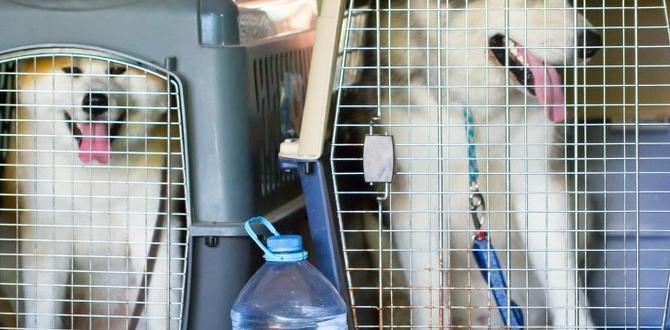Have you ever noticed your dog getting anxious when you leave? It’s a common problem many pet owners face. This feeling is known as separation anxiety. It can lead to barking, chewing, and even accidents in the house. But there is hope! Crate training can help your furry friend feel safe and relaxed when you’re not home.
Imagine this: you head out for a quick grocery run, and your dog starts howling like it’s the end of the world. Sound familiar? You’re not alone! Many dogs struggle with being left alone. The good news is that crate training is an effective way to ease their worry. It helps them learn that it’s okay to be alone for a little while.
Did you know that dogs are den animals? They naturally seek small, cozy spaces for comfort. A crate can become their safe haven. When done right, crate training can reduce their anxiety and give you peace of mind.
In this article, we will explore how to crate train your dog effectively. You’ll learn tips and tricks to make the journey easier for both of you. Ready to find out how crate training can help your dog with separation anxiety? Let’s dive in!
Understanding Separation Anxiety In Crate Training Dogs

Understanding Separation Anxiety and Crate Training
Separation anxiety is tough for pets and their owners. Have you noticed your dog barking or scratching when you leave? Crate training can help! A crate creates a safe space, reducing anxiety. This method teaches dogs that being alone isn’t scary. Start with short periods to keep it positive. Over time, your furry friend will feel more comfortable alone. Remember, patience is key. Your dog can learn to relax and trust you will always return.Understanding Separation Anxiety in Dogs
Definition and symptoms of separation anxiety. Causes and contributing factors of separation anxiety.Separation anxiety in dogs is a condition where pets experience distress when left alone. This can show in many ways. Common symptoms include barking, chewing, and toilet accidents. Understanding the causes helps manage this issue. Often, dogs may feel insecure due to:
- Changes in routine
- Moving to a new home
- Loss of a family member or pet
- Lack of early socialization
Recognizing these signs and triggers can greatly help in easing their worries.
What should I watch for if my dog has separation anxiety?
Look for barking, digging, or attempting to escape when you leave them alone.
The Importance of Crate Training
Benefits of crate training for dogs. How crate training helps alleviate separation anxiety.Crate training is a valuable tool for dogs and their owners. It provides a safe space for pets to relax. Benefits of crate training include helping dogs feel secure and comfortable. A crate can reduce anxiety during times of separation. Many dogs feel calm in their crates, making it easier when you leave home. It’s like a cozy den for them. This can lead to happier, less stressed dogs and better behavior overall.
- Creates a safe environment
- Helps with potty training
- Reduces destructive behavior
- Builds a bond between dog and owner
How does crate training help with separation anxiety?
Crate training helps dogs feel secure during separation. It gives them a personal space they can trust. When they understand their crate is a safe place, they worry less when you leave. This can ease their fears and lower anxiety levels.
Choosing the Right Crate
Types of crates (wire, plastic, softsided). Factors to consider for size and comfort.Finding the right crate is key for your pet’s comfort. There are three main types: wire, plastic, and soft-sided. Wire crates offer ventilation and visibility. Plastic crates are cozy and good for travel. Soft-sided crates are lightweight and portable. When choosing, consider your pet’s size and how much room they need to move. Here are some tips:
- Measure your pet’s height and length.
- Choose a crate that’s tall enough for them to stand.
- Ensure it’s long enough for them to lie down comfortably.
With a comfortable crate, your pet will feel safe, even during separation anxiety.
What size crate should I get for my dog?
The crate size depends on your dog’s weight and height. Choose a crate where your dog can stand, turn, and lie down easily. A larger crate can lead to accidents, while a smaller crate may feel cramped.
Steps to Introduce Crate Training
Gradual acclimatization to the crate. Positive reinforcement techniques during training.Start crate training slowly. Let your pet explore the crate. Leave the door open so it feels safe. Place comfy bedding inside to make it inviting. Use treats to encourage your pet to enter. Positive reinforcement helps a lot. Reward them with praise and snacks when they go inside. This builds a happy connection to the crate. Gradual introductions will help reduce any fear. Soon, they will see the crate as a cozy place.
How can I make crate training easier for my pet?
Start with short periods and gradually increase the time. Use treats and praise to encourage good behavior. This will help your pet feel safe and happy.
Tips for Positive Reinforcement:
- Always reward your pet after placing them in the crate.
- Use the crate for feeding or playtime at first.
- Be patient and consistent with your training.
Establishing a Routine
Importance of consistency in training. Creating a daily schedule to foster security.Having a routine helps your pet feel safe. Pets love knowing what will happen each day. Consistency in training is key. This builds trust between you and your furry friend. Create a daily schedule. Follow these steps:
- Feed at the same time.
- Take them for walks regularly.
- Set training times.
- Give them playtime.
With a steady routine, your pet learns what to expect. This can reduce their anxiety and build confidence. Remember, practice makes perfect!
How does routine help with separation anxiety?
Routine provides comfort and predictability, which helps reduce stress for your pet.Addressing Challenges During Crate Training
Common issues owners face (barking, whining). Solutions for overcoming these challenges.Crate training can feel like an uphill battle sometimes. Have you dealt with barking or whining? You’re not alone! Many pet owners face these issues. The main reason is often anxiety. To tackle this, try giving your puppy a treat before closing the crate door. Another trick is to gradually increase the time they spend inside. Soon, they’ll think of it as their cozy den instead of a lonely box!
| Common Issues | Solutions |
|---|---|
| Barking | Use treats to reward calm behavior. |
| Whining | Double the cuddle time before crating. |
With patience and a sprinkle of humor, crate training can become less of a circus act and more of a walk in the park!
Advanced Techniques for Severe Separation Anxiety
Behavioral modification strategies. Consulting with a professional trainer or behaviorist.Severe separation anxiety in pets can be tough, but don’t worry—there are effective techniques! Start by using behavioral modification strategies. These include rewards for calm behavior and short departures to build confidence. Next, consider consulting with a professional trainer or behaviorist. They have the skills to help pets adjust and can create a tailored plan. Remember, even the best trainers can’t work magic; a little patience, love, and maybe some treats go a long way!
| Technique | Description |
|---|---|
| Rewards | Give treats for being calm when you’re gone. |
| Short Departures | Leave for a few minutes to build confidence. |
| Professional Help | A trainer can create a special plan for your pet. |
Monitoring Progress and Adjustments
Signs of improvement to look for. When to adjust training techniques.Watching your pet’s progress is key in training! Look for signs like calm behavior or easier crate time. If they whine less or can stay in the crate longer, that’s a win! You might say, “Hooray! We’re on the right track!” But if your furry friend suddenly starts acting out, it might be time to change things up. Use shorter training sessions or add more playtime. Let’s keep the vibes positive while making adjustments!
| Signs of Improvement | Adjustments to Make |
|---|---|
| Less whining | Shorten crate time |
| Longer calm periods | Add more playtime |
Alternative Solutions for Managing Separation Anxiety
Other methods besides crate training. Supplements and anxietyreducing products.To help pets with separation anxiety, there are fun tricks aside from crate training. You can use special supplements like calming treats to soothe their nerves. Ever heard of a lavender-scented collar? Talk about fancy fashion! Some owners swear by anxiety-reducing products like thundershirts, wrapping their pooch in a cozy hug. Here’s a quick look at some helpful options:
| Method | Description |
|---|---|
| Calming Treats | Tasty snacks with ingredients that help reduce anxiety. |
| Thundershirts | A snug shirt that makes dogs feel safe, like a warm hug. |
| Natural Supplements | Vitamins or herbs that promote relaxation. |
Keep experimenting! Sometimes, a mix of cuddles and these tools works wonders for our furry friends.
Success Stories and Case Studies
Reallife examples of improved separation anxiety through crate training. Testimonials from dog owners.Many dog owners share amazing stories about how crate training helped their furry friends overcome separation anxiety. For instance, Alex found that after a few weeks, his dog Luna went from whining and scratching the door to napping happily in her crate. “Luna now thinks it’s a cozy fort!” he chuckles.
In another case, Sara’s pup Charlie went from vocal protests to peaceful snoozes. “Now, I can leave the house without worrying about him hosting a demolition party,” she laughs. These real-life examples show how crate training can be a game changer.
| Dog Owner | Dog’s Name | Before Crate Training | After Crate Training |
|---|---|---|---|
| Alex | Luna | Whining and scratching | Napping happily |
| Sara | Charlie | Vocal protests | Peaceful snoozes |
These tales show that patience really pays off! Crate training isn’t just about a doggie timeout; it’s about building trust and comfort.
Conclusion
In summary, separation anxiety crate training helps your pet feel safe and secure. Start by introducing the crate slowly. Use treats and toys to create positive experiences. Practice short absences, then gradually increase the time you’re gone. Remember, patience is key! If you want to learn more, check out books or videos on crate training. Your pet will thank you!FAQs
Sure! Here Are Five Related Questions On The Topic Of Separation Anxiety And Crate Training:Separation anxiety is when a pet feels very scared or sad when you leave. Crate training helps your pet feel safe, like having their own cozy room. Start by letting your pet explore the crate with the door open. Then, you can close the door for a little while. This helps them learn that being in the crate is okay, even when you’re not there.
Sure! Please provide me with the question you would like me to answer.
What Are The Signs That A Dog Is Experiencing Separation Anxiety When Left In A Crate?When a dog has separation anxiety in a crate, you might see some clear signs. They might bark a lot or whine when you leave. Some dogs may scratch at the crate or try to escape. You could also find that they have accidents inside the crate or chew on things. If your dog acts very anxious or scared, they might be feeling this way.
How Can Crate Training Help Alleviate Separation Anxiety In Dogs?Crate training can help your dog feel safe when you leave. A crate is like a cozy room just for them. When they stay in the crate, they learn that it’s okay to be alone. This can make them less scared when you go out. Over time, your dog might feel more relaxed and happy by themselves.
What Are Some Effective Techniques For Accustoming A Dog To A Crate To Prevent Separation Anxiety?To help your dog feel comfy in a crate, start by making it a happy space. You can put your dog’s favorite blanket and toys inside. Give your dog treats when they go into the crate. Start by closing the door for a short time, then let them out. Gradually make the time longer so your dog gets used to it. Always stay calm and patient!
How Long Should A Dog Be Left In A Crate During Training To Minimize Anxiety And Promote Comfort?You should not leave a dog in a crate for too long. Puppies can stay for about one hour for each month of age. So, a two-month-old puppy can be in the crate for two hours. Adult dogs can usually stay for about four to six hours. Always make sure your dog has enough time outside to play and go to the bathroom.
What Are Some Alternatives To Crate Training For Dogs That Struggle With Severe Separation Anxiety?If your dog has bad separation anxiety, you can try a few different things. You could use a safe room instead of a crate. Put your dog’s bed and toys there to make it comfy. You can also give your dog puzzle toys or treat dispensers to keep them busy. Another idea is to practice short departures, so your dog gets used to being left alone.
Meet Elyse Colburn, the devoted canine companion and storyteller behind the enchanting world of “Tales, Tails, and Adventures Unleashed.” A passionate dog enthusiast with a heart full of paw prints, Elyse Colburn shares heartwarming tales and insightful adventures, celebrating the joy, loyalty, and endless antics that make every dog a true hero. Join Elyse Colburn on this tail-wagging journey, where every post is a love letter to our four-legged friends.







